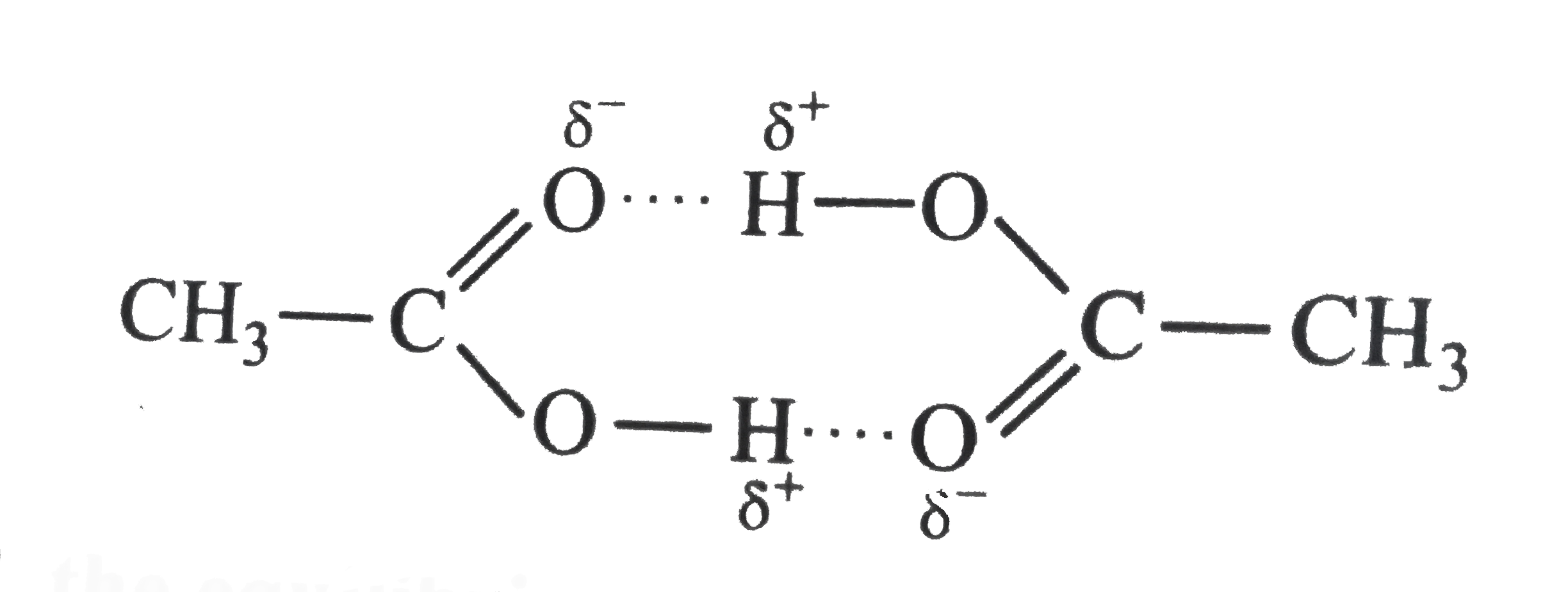Acetic acid undergoes dimerization in benzene solution. When the concentration of the reactant is increased, the position of equilibrium in the reaction 2CH3COOH⇔(CH3COOH)2 is shifted Solution in Malayalam
to the right
to the left
neither to left nor to right
none of these
The correct Answer is:B
2CH3COOH⇔(CH3COOH)2. As volume increases concentration decreases, reaction quotient increases for the equilibrium.
Topper's Solved these Questions
- BOOK - BRILLIANT PUBLICATIONCHAPTER - CHEMICAL AND IONIC EQUILIBRIUMEXERCISE - Level -II52videos
CHEMICAL AND IONIC EQUILIBRIUM
- BOOK - BRILLIANT PUBLICATIONCHAPTER - CHEMICAL AND IONIC EQUILIBRIUMEXERCISE - Level - III19videos
CHEMICAL AND IONIC EQUILIBRIUM
- BOOK - BRILLIANT PUBLICATIONCHAPTER - CHEMICAL AND IONIC EQUILIBRIUMEXERCISE - Questions20videos
CHEMICAL AND IONIC EQUILIBRIUM
- BOOK - BRILLIANT PUBLICATIONCHAPTER - CHEMICAL BONDINGEXERCISE - LEVEL-III ( Linked Comprehension Type )12videos
CHEMICAL BONDING
Similar Questions
For the following three reactions (i), (ii) and (iii), equilibrium constants are given:
i) CO(g)+H2O(g)⇔CO2(g)+H2(g),K1
ii) CH4(g)+H2O(g)⇔CO(g)+3H2(g),K2
iii) CH4(g)+2H2O(g)⇔CO2(g)+4H2(g),K3
Which of the following relation is correct?04:51View SolutionStarting with 1 mol of O2:2 mol of SO2, the equilibrium for the formation of SO3(g) was established a certain temperature. If V is the volume of the vessel and 2x is the number of moles of SO3 present, equilibrium constant for the reaction 2SO2(g)+O2(g)⇔2SO3(g) would be :
09:55View SolutionThe equilibrium, concentration of H2,I2, and HI are respectively 5.0,3.0 and 17molL−1 . What will be the value of Kc for the reaction H2+I2 → 2HI ?
09:55View SolutionIn an ionic bond, the cation tends to polarize the electron cloud of the anion by pulling electron dens towards itself. This causes development of covalent character in the ionic bond because the electron dens gets localised in-between the nuclei. The tendency of the cation to bring about the polarization of the anion expressed as its polarizing power. The ability of ion to undergo polarization is called its polarisability. The polarising power of a cation or an anion is decided on the basis of Fajans' rules.
The ionic conductance of which of the following is the highest?09:55View SolutionAcetoc acid CH_(3)COOH can form a dimer (CH_(3)COOH)_(2) in the gas phase. The dimer is held togther by two H- bonds with a total strength of 60.0 kJ per mole of dimer If at 25^(@)C , the equilibrium constant for the dimerisation is 1.3 xx 10^(3) , calculate DeltaS^(Theta) for the reaction 2CH_(3)COOH (g) hArr (CH_(3)COOH)_(2)(g)
02:11View SolutionAcetic acid tends to form dimer due to formation of intermolcular hydrogen bonding. 2CH_(2)COOHhArr(CH_(3)COOH)_(2) The equilibrium constant for this reaction is 1.5xx10^(2)M^(-1) in benzene solution and 3.6xx10^(-2) in water. In benzene, monomer does not dissociate but it water, monomer dissociation simultaneously with acid dissociation constant 2.0xx10^(-5) M. Dimer does not dissociate in benzene as well as water. The molar ration of dimer to monomer for 0.1 M acetic acid in benzene is equal to :
03:15View SolutionAcetic acid tends to form dimer due to formation of intermolcular hydrogen bonding. 2CH_(2)COOHhArr(CH_(3)COOH)_(2) The equilibrium constant for this reaction is 1.5xx10^(2)M^(-1) in benzene solution and 3.6xx10^(-2) in water. In benzene, monomer does not dissociate but it water, monomer dissociation simultaneously with acid dissociation constant 2.0xx10^(-5) M. Dimer does not dissociate in benzene as well as water. The molar ratio of dimer to monmer for 0.1M acetic acid in water (neglecting the dissciation of acetic acid in water ) is equal to :
View SolutionAcetic acid tends to form dimer due to formation of intermolcular hydrogen bonding.
2CH2COOH⇔(CH3COOH)2
The equilibrium constant for this reaction is 1.5×102M−1in benzene solution and 3.6×10−2 in water. In benzene, monomer does not dissociate but it water, monomer dissociation simultaneously with acid dissociation constant 2.0×10−5M. Dimer does not dissociate in benzene as well as water.
The pH of 0.1M acetic acid solution in water, considering the simultaneous dimerisation and dissociation of acid is :03:06View SolutionAcetic acid forms dimer in vapour phase. The dimer is held together by two hydrogen bonds with a total strength of 66.5 kJ per mole of dimer. If at 25∘C, the equilibrium constant for the dimerisation is 1.3×103. ΔS∘ for the reaction 2CH3COOH⇔(CH3COOH)2 will be (log1.3=0.1139)
01:54View SolutionOne mole of CH3COOH undergo dimerization in vapour state at 127∘C as 2CH3COOH(g)⇔(CH3COOH)2 if dimer formation is due to two H-bonds involved in dimer, each of 33kJ strenght and the degree of dimerization of acetic acid 98.2% which is correct
02:55View Solutionसमान सांद्रता युक्त एसिटिक अम्ल मोनोक्लोरो एसिटिक अम्ल तथा ट्रीक्लोरो एसिटिक अम्ल के जलिये विलयन के क्वथनक में उन्नयन निम्नलिखित क्रम के अनुसार बढ़ता है समझय CH3COOH<।CICH2−COOH<CI3−COOH
04:36View SolutionIn the acid - base reaction,
HCl+CH3COOH⇔Cl−+CH3COOH+2
the conjugate acid of acetic acid is02:34View SolutionAcetic acid dissociates as
CH3COOH⇔CH3COO−+H+ . If a little amount of sodium acetate is added to its aqueous solution06:49View SolutionA buffer solution is prepared by mixing CH_(3) COONa and CH_(3) COOH . The pK_(a) of acetic acid is 4.74 . To maintain the pH of the buffer solution as 6.04 , the concentration ratio of CH_(3) COONa and CH_(3) COOH to be maintained is
03:18View SolutionAcetic acid CH3COOH can form a dimer (CH3COOH)2 in the gas phase. The dimer is held togther by two H−bonds with a total strength of 60.0kJper mole of dimer

If at 25∘C, the equilibrium constant for the dimerisation is 1.3×103, calculate ΔSΘ for the reaction
2CH3COOH(g)⇔(CH3COOH)2(g)02:47View SolutionAcetic acid undergoes dimerization in benzene solution. When the solution is diluted to twice the original volume, the position of equilibrium in the reaction 2 CH _(3) COOH hArr COOH hArr (CH _(3) COOH ) _(2) is shifted
03:44View Solution

